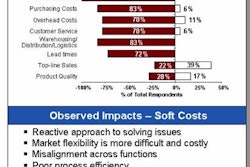Scottsdale, AZ — October 13, 2008 — The stock market may be rebounding after a historic drop last week, but even before the recent selloff on Wall Street, manufacturers still trying to make a living on Main Street were struggling, with new orders falling at record rates.
Exhibit A: Markit, a financial information company, reported at the beginning of this month that manufacturing output in Britain hit an astounding 17 year low. The U.S. Census Bureau also announced the troubling news that orders for durable goods decreased by 4.5 percent in the month of August 2008.
Despite joint actions by governments in developed nations over the weekend, the heightened financial sector turmoil and tighter credit conditions are significantly raising the danger of prolonging the downturn. This kind of news can rock the nerves of even the toughest CEOs and CFOs who are responsible for managing some of the largest manufacturers in the world.
Besides developing deep circles under the eyes from sleepless nights, what can manufacturers do to win in such a tough and volatile economy? David Johnston, senior vice president for manufacturing and wholesale distribution at solution provider JDA Software, offered several strategies that manufacturers can deploy now to drive margins and protect shareholder value in the current economic climate:
1) Immediately Analyze Demand to Identify the Shifts in Customer Buying Behavior
The buying habits and preferences of consumers and businesses inevitably have, and will continue, to change in response to the slowing economy. Manufacturers should quickly dedicate the time and effort to apply an additional level of scrutiny to analyze demand to identify the products with significant upward or downward trends. The forecast of these items should be aggressively adjusted to reflect the shifts in product preference as consumers make tradeoffs in price, package size quantities and value versus premium offerings.
By quickly aligning forecasts to reflect the current economic conditions, manufacturers can establish the foundation for making strategic, profitable changes to inventory policies, product mix, production plans and procurement plans. Every manufacturer is forecasting demand to some degree of accuracy today. The question has become: Is your demand signal visibility sufficiently accurate, dynamic and comprehensive enough to manage every echelon in your extended supply chain?
2) Quickly Make Adjustments to Inventory Policies to Align Them with Shifting Demand Patterns
Manufacturers should adjust their safety-stock level policies to place a greater emphasis on those products that are trending upward, and less emphasis on those that have a significant downward trend. This is an easy way to quickly align working capital investments with the changes in product mix driven by tradeoffs made by consumers in response to the economic downturn.
Another quick-win strategy is to slightly raise the safety stock levels of those products that have remained fairly stable and that reflect significant volume and reasonable margins. This strategy will squeeze out additional margin dollars through recovery of some lost sales with a minimum incremental working capital investment.
3) Change the Product Mix Strategy to Place Additional Emphasis on Value-based Products
As both consumers and businesses rein in spending, they will reevaluate their budgets and suspend buying premium products that are nonessential and tradeoff to buy more value-based products. Manufacturers should adjust production plans to allocate more capacity to value-based product lines and position themselves to grab market share from competitors by appealing to the more cost-conscious buyers.
At the same time, manufacturers should examine the raw materials used to produce products for potential upstream savings to garner additional margins. As consumers trade down, there is also the opportunity to garner additional margins from value lines by executing well-timed pricing actions.
4) Collaborate with Channel Partners to Promote Products with Bloated Inventories Caused by the Downturn
For the products that have fallen victim to the abrupt economic downturn, manufacturers should work collaboratively with their channel partners to aggressively promote those products, alleviating excess levels of inventory. This action can free up much needed working capital. Although there may be an immediate impact on margins, the additional capital could be used to invest in areas where growth is still achievable.
5) Collaborate with Transportation Providers to Receive Preferred Rates
The high cost of fuel coupled with constrained transportation capacities have resulted in steady increases in freight rates and fuel surcharges. As the drop in factory orders brings the transportation demand back in line with capacity, manufacturers should leverage the opportunity to collaborate with transportation carriers to receive lower rates.
In exchange, manufacturers should offer to provide transportation providers with better visibility into their capacity needs, and work with them to identify additional opportunities and to potentially agree to shorten payment terms if feasible.
6) As a Post Mortem: Assess the Flexibility of the Supply Chain Based on How Quickly New Strategies Can be Deployed
Manufacturers need to take the opportunity to quickly assess the flexibility and competitive advantage that their supply chains provide by evaluating and scoring their readiness to enable a rapid change in product and inventory strategies. The score should be penalized if any of the following are discovered in this assessment:
Exhibit A: Markit, a financial information company, reported at the beginning of this month that manufacturing output in Britain hit an astounding 17 year low. The U.S. Census Bureau also announced the troubling news that orders for durable goods decreased by 4.5 percent in the month of August 2008.
Despite joint actions by governments in developed nations over the weekend, the heightened financial sector turmoil and tighter credit conditions are significantly raising the danger of prolonging the downturn. This kind of news can rock the nerves of even the toughest CEOs and CFOs who are responsible for managing some of the largest manufacturers in the world.
Besides developing deep circles under the eyes from sleepless nights, what can manufacturers do to win in such a tough and volatile economy? David Johnston, senior vice president for manufacturing and wholesale distribution at solution provider JDA Software, offered several strategies that manufacturers can deploy now to drive margins and protect shareholder value in the current economic climate:
1) Immediately Analyze Demand to Identify the Shifts in Customer Buying Behavior
The buying habits and preferences of consumers and businesses inevitably have, and will continue, to change in response to the slowing economy. Manufacturers should quickly dedicate the time and effort to apply an additional level of scrutiny to analyze demand to identify the products with significant upward or downward trends. The forecast of these items should be aggressively adjusted to reflect the shifts in product preference as consumers make tradeoffs in price, package size quantities and value versus premium offerings.
By quickly aligning forecasts to reflect the current economic conditions, manufacturers can establish the foundation for making strategic, profitable changes to inventory policies, product mix, production plans and procurement plans. Every manufacturer is forecasting demand to some degree of accuracy today. The question has become: Is your demand signal visibility sufficiently accurate, dynamic and comprehensive enough to manage every echelon in your extended supply chain?
2) Quickly Make Adjustments to Inventory Policies to Align Them with Shifting Demand Patterns
Manufacturers should adjust their safety-stock level policies to place a greater emphasis on those products that are trending upward, and less emphasis on those that have a significant downward trend. This is an easy way to quickly align working capital investments with the changes in product mix driven by tradeoffs made by consumers in response to the economic downturn.
Another quick-win strategy is to slightly raise the safety stock levels of those products that have remained fairly stable and that reflect significant volume and reasonable margins. This strategy will squeeze out additional margin dollars through recovery of some lost sales with a minimum incremental working capital investment.
3) Change the Product Mix Strategy to Place Additional Emphasis on Value-based Products
As both consumers and businesses rein in spending, they will reevaluate their budgets and suspend buying premium products that are nonessential and tradeoff to buy more value-based products. Manufacturers should adjust production plans to allocate more capacity to value-based product lines and position themselves to grab market share from competitors by appealing to the more cost-conscious buyers.
At the same time, manufacturers should examine the raw materials used to produce products for potential upstream savings to garner additional margins. As consumers trade down, there is also the opportunity to garner additional margins from value lines by executing well-timed pricing actions.
4) Collaborate with Channel Partners to Promote Products with Bloated Inventories Caused by the Downturn
For the products that have fallen victim to the abrupt economic downturn, manufacturers should work collaboratively with their channel partners to aggressively promote those products, alleviating excess levels of inventory. This action can free up much needed working capital. Although there may be an immediate impact on margins, the additional capital could be used to invest in areas where growth is still achievable.
5) Collaborate with Transportation Providers to Receive Preferred Rates
The high cost of fuel coupled with constrained transportation capacities have resulted in steady increases in freight rates and fuel surcharges. As the drop in factory orders brings the transportation demand back in line with capacity, manufacturers should leverage the opportunity to collaborate with transportation carriers to receive lower rates.
In exchange, manufacturers should offer to provide transportation providers with better visibility into their capacity needs, and work with them to identify additional opportunities and to potentially agree to shorten payment terms if feasible.
6) As a Post Mortem: Assess the Flexibility of the Supply Chain Based on How Quickly New Strategies Can be Deployed
Manufacturers need to take the opportunity to quickly assess the flexibility and competitive advantage that their supply chains provide by evaluating and scoring their readiness to enable a rapid change in product and inventory strategies. The score should be penalized if any of the following are discovered in this assessment:
- Many of the adjustments required to deploy the new strategy have to be performed manually or in spreadsheets.
- The only way to coordinate the deployment of strategy changes across the supply chain processes is through meetings and e-mail exchanges.
- It takes days or even weeks for the forecast changes and demand shaping activities to be reflected in the distribution, production, procurement and transportation plans.
- There is no way to quickly evaluate how the change in strategies would impact revenues, margins and the resulting operational plans.
- There is no sales and operations planning (S&OP) process, or the S&OP process in place is not adequate to accurately evaluate the change in strategy prior to deployment.



















